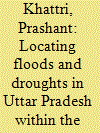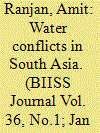| Srl | Item |
| 1 |
ID:
145391


|
|
|
|
|
| Summary/Abstract |
The Indian scenario of disaster management is largely guided by two documents viz- the Disaster Management Act (DMA), 2005 and the National Policy on Disaster Management (NPDM), 2009. As recently as on February 26, 2013, a multi-stakeholder National Platform for Disaster Risk Reduction (NPDRR) has been constituted by the Government which is headed by the Union Home Minister and which has a tenure of not more than five years, after which a review of its constitution shall take place.
|
|
|
|
|
|
|
|
|
|
|
|
|
|
|
|
| 2 |
ID:
140305


|
|
|
|
|
| Summary/Abstract |
Water conflict in South Asia is one of the critical challenges for the region. The unitary irrigation system constructed since Mughal period was divided in 1947, when the sub-continent was partitioned into India and Pakistan. Not enthusiastic to break the then existing hydrological, railway and port systems, Sir Cyril Radcliffe took ‘other factors’ also into consideration and not only religion as a sole determinant to partition the sub-continent. Despite his efforts, the water bodies were divided between the two arch enemies. Soon after the partition, the conflicts over shared water bodies started and have been graduated over the decades. The political animosities among the South Asian neighbours have inflamed the water conflicts further. As a result, arrangements, agreements and treaties seeking cooperation over shared water resources have failed to address water related grievances of each country. One common allegation the neighbouring countries have is that India exploits their resources for its own use. This allegation helps the radical elements from those countries to espouse the causes and raise the cries of water nationalism. Not only in those countries, the feeling of ‘sovereign’ rivers is also strong in India. The political tensions over water are duly aided by the growing supply-demand gap, phenomenon of climate change and predominant use of supply-side management system. Though the water conflicts are bilateral, it has regional implications. Realising this fact, in most of the regions, the regional organisations have taken steps to mitigate differences among the riparian states and have helped them to enter into a cooperative arrangement. In South Asia, this is difficult to attain because the South Asia Association for Regional Cooperation (SAARC) is not a very effective body.
|
|
|
|
|
|
|
|
|
|
|
|
|
|
|
|